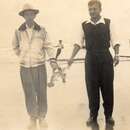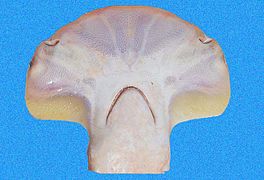en
names in breadcrumbs


Der Korona-Hammerhai (Sphyrna corona) ist mit einer maximalen Länge von bis zu 92 Zentimetern der kleinste Hai innerhalb der Familie der Hammerhaie (Sphyrnidae). Er lebt entlang der subtropischen und tropischen Küste des östlichen Pazifiks von Mexiko bis Peru.
Der Korona-Hammerhai ist die kleinste der bekannten Arten innerhalb der Hammerhaie mit einer durchschnittlichen Länge zwischen 60 und 70 Zentimetern und einer maximalen Körperlänge von bis zu 92 Zentimetern.[1][2] Der Rücken ist grau, die Körperunterseite weiß gefärbt. Der Kopf bzw. das Cephalofoil ist im Vergleich zu anderen Hammerhaien weniger stark verbreitert und besitzt eine vergleichsweise lange Schnauze. Es erreicht eine Breite von maximal 2/5 der Gesamtlänge des Hais. Die Vorderseite ist bogenförmig mit deutlichen Einkerbungen in der Mitte und an beiden Kopfenden. Das Maul ist klein und stark gebogen.[1]
Die erste Rückenflosse ist leicht sichelförmig und ist oberhalb des Brustflossenansatzes angeordnet, der Hinterrand der Afterflosse ist nahezu gerade.[1]
Der Korona-Hammerhai lebt in den tropischen Gewässern des Pazifischen Ozeans von Mexiko bis Peru vorwiegend in Küstennähe im Bereich der Festlandsockel.
Über die Lebensweise des Korona-Hammerhais liegen nur wenige Daten vor. Wie andere kleine Hammerhai-Arten ernährt er sich wahrscheinlich vor allem von wirbellosen Tieren und kleineren Knochenfischen.
Wie alle Hammerhaie ist diese Art lebendgebärend (ovovivipar), wobei die ungeborenen Junghaie über eine Dottersack-Plazenta ernährt werden. Dabei wird der Dottersack, nachdem der Dottervorrat von den Junghaien verbraucht ist, in eine Plazenta umgebildet, die funktional der eines Säugetiers entspricht und im Laufe der weiteren Entwicklung die Ernährung über den mütterlichen Blutkreislauf sicherstellt.
Das Weibchen bekommt wahrscheinlich in der Regel zwei Jungtiere von bis 23 Zentimetern Länge. Die Korona-Hammerhaie erreichen die Geschlechtsreife bei einer Länge von etwa 60 Zentimetern.
Die International Union for Conservation of Nature (IUCN) stuft diesen Hai als gering gefährdet („Near Threatened“) ein, da er potenziell unter einem intensiven Fischereidruck steht und durch seine geringe Reproduktionsrate sehr anfällig für einen Populationsrückgang ist.[3] Bei der Einordnung wird allerdings betont, dass die Art aufgrund ihres begrenzten Verbreitungsgebietes sowie der geringen Reproduktionsrate wahrscheinlich analog zum Kleinaugen-Hammerhai (Sphyrna tudes) auch als gefährdet gelten kann, allerdings gibt es derzeit keine Daten, die einen Rückgang der Population nachweisen.[3]
Der Korona-Hammerhai (Sphyrna corona) ist mit einer maximalen Länge von bis zu 92 Zentimetern der kleinste Hai innerhalb der Familie der Hammerhaie (Sphyrnidae). Er lebt entlang der subtropischen und tropischen Küste des östlichen Pazifiks von Mexiko bis Peru.
The scalloped bonnethead (Sphyrna corona) is a rare, little-known species of hammerhead shark in the family Sphyrnidae. Its other common names include the mallethead shark and the crown shark.[1] It is found in tropical and subtropical waters in the eastern Pacific Ocean, from Mexico to Peru, and possibly as far north as the Gulf of California.[3] It frequents inshore habitats over soft bottoms (mud, sand, and gravel) to a depth of 100 m, and also enters mangroves and estuaries.[4]
Probably the smallest species of hammerhead shark, the scalloped bonnethead measures up to 92 centimetres (36 in) long.[5] Its mallet-shaped head, called a cephalofoil, is moderately wide (24–29% of total length) and elongated lengthwise. The front margin is broadly arched, with shallow lateral and medial indentations, and no prenarial grooves. The mouth is small and strongly arched. The anal fin is long and has a nearly straight rear margin. Its coloration is gray above and white below, with no prominent fin markings. The similar scoophead (S. media) can be distinguished by a shorter snout, a broader mouth, and a deeply concave anal fin margin.[3]
Like other hammerheads, the scalloped bonnethead is viviparous, with presumably two pups per litter. The young are born at 23 centimetres (9.1 in) or above; an adolescent male has been recorded at 51 centimetres (20 in) long, and an adult at 67 centimetres (26 in). It may be taken by local inshore fisheries, but data is lacking.[3] It feeds on or near the bottom, on crustaceans, molluscs, cephalopods, echinoderms, and bony fishes.[4]
The scalloped bonnethead (Sphyrna corona) is a rare, little-known species of hammerhead shark in the family Sphyrnidae. Its other common names include the mallethead shark and the crown shark. It is found in tropical and subtropical waters in the eastern Pacific Ocean, from Mexico to Peru, and possibly as far north as the Gulf of California. It frequents inshore habitats over soft bottoms (mud, sand, and gravel) to a depth of 100 m, and also enters mangroves and estuaries.
Probably the smallest species of hammerhead shark, the scalloped bonnethead measures up to 92 centimetres (36 in) long. Its mallet-shaped head, called a cephalofoil, is moderately wide (24–29% of total length) and elongated lengthwise. The front margin is broadly arched, with shallow lateral and medial indentations, and no prenarial grooves. The mouth is small and strongly arched. The anal fin is long and has a nearly straight rear margin. Its coloration is gray above and white below, with no prominent fin markings. The similar scoophead (S. media) can be distinguished by a shorter snout, a broader mouth, and a deeply concave anal fin margin.
Like other hammerheads, the scalloped bonnethead is viviparous, with presumably two pups per litter. The young are born at 23 centimetres (9.1 in) or above; an adolescent male has been recorded at 51 centimetres (20 in) long, and an adult at 67 centimetres (26 in). It may be taken by local inshore fisheries, but data is lacking. It feeds on or near the bottom, on crustaceans, molluscs, cephalopods, echinoderms, and bony fishes.

Head, underside

Head, top side

Jaws
La cornuda coronada (Sphyrna corona) es una especie poco común y poco conocida de tiburón martillo. Habita en las aguas tropicales y subtropicales del océano Pacífico oriental, desde México hasta Perú, y posiblemente hasta el golfo de California. Frecuenta las zonas costeras con fondos suaves (lodo, arena y grava) a profundidades de 100 m, además de manglares y estuarios.
La cornuda coronada (Sphyrna corona) es una especie poco común y poco conocida de tiburón martillo. Habita en las aguas tropicales y subtropicales del océano Pacífico oriental, desde México hasta Perú, y posiblemente hasta el golfo de California. Frecuenta las zonas costeras con fondos suaves (lodo, arena y grava) a profundidades de 100 m, además de manglares y estuarios.
Sphyrna corona Sphyrna generoko animalia da. Arrainen barruko Sphyrnidae familian sailkatzen da.
Sphyrna corona Sphyrna generoko animalia da. Arrainen barruko Sphyrnidae familian sailkatzen da.
Sphyrna corona
Sphyrna corona (le Requin-marteau cornu) est une espèce de requins de la famille des Sphyrnidae.
Petit requin ayant une tête en forme de marteau large et légèrement cambrée.
La taille moyenne se situe entre 60 et 70 centimètres, la taille maximale probablement 90 centimètres. C'est la plus petite espèce de requin-marteau.
Le requin-marteau cornu vit à l’est de l’Océan Pacifique, dans le Golfe de Californie, et du Mexique jusqu'au Pérou. Il fréquente les habitats côtiers sur des fonds mous (sable ou gravier) à une profondeur d'environ 100 m et une température pouvant aller jusqu'à 27°C. On peut observer ce petit requin dans les mangroves et les estuaires.
Vivipare, il a probablement deux petits par portée. La taille à la naissance est de 25 centimètres. Les mâles atteignent la maturité sexuelle vers 65 centimètres.
Ce petit requin est menacé par la pêche artisanale ce qui le rend très vulnérable. Le taux faible de reproduction est également un des facteurs de sa rareté. Malheureusement en l’absence de données sur leur recensement, la pêche n’a pas encore été interdite et ce requin n’est pas une espèce protégée.
Sphyrna corona
Sphyrna corona (le Requin-marteau cornu) est une espèce de requins de la famille des Sphyrnidae.
홍살보닛헤드귀상어(학명: Sphyrna corona)는 흉상어목 귀상어과에 속하는 물고기이다. 몸길이는 1.7m로 상어에서는 중소형인 어종에 속한다.
홍살보닛헤드귀상어는 몸의 옆줄을 기점으로 몸의 등쪽은 붉은색, 보라색, 회색이 섞여 있으며 영어권에서는 스캘롭트 보닛헤드 샤크(Scalloped bonnethead Shark)라는 이름으로 불린다. 귀상어과에 속하는 어종들 중에서 작은 종으로 평균적으로 92cm의 길이로 측정하는 어종이다. 세팔로포일이라 불리는 망치의 모양을 가진 머리는 총 길이의 24%~29%로서 적당히 넓으며 길쭉하게 길어진 것이 특징이다. 전면의 마진은 얕은 측면 및 내측 들여쓰기로 광범위한 아치형의 모습으로 사전 홈이 없다. 입은 작고 강한 아치형의 모습을 가지고 있다. 항문지느러미는 길고 거의 직선 후면의 마진을 가진다. 등지느러미는 2개이며 제1등지느러미는 가슴지느러미가 끝나는 바로 윗부분에서 시작하며 제2등지느러미는 항문지느러미가 끝나는 바로 윗부분에서 시작한다. 항문지느러미의 색은 위의 회색과 아래의 흰색을 가지고 있으며 눈에 띄는 지느러미의 표시가 없다. 특징이 대체적으로 유사한 귀상어와는 더 짧은 주둥이와 입이 넓은 특징과 깊은 오목한 항문지느러미의 마진으로 구분할 수가 있다. 양턱에는 각각 14개~16개의 이빨이 존재하며 위턱의 이빨은 톱의 모양을 가지고 아래턱의 이빨은 삼각형의 모양을 가진다. 먹이로는 멸치, 청어, 정어리, 고등어와 같은 물고기들과 오징어와 같은 두족류, 갑각류, 연체동물, 극피동물들을 섭식하는 육식성물고기에 속한다.
홍살보닛헤드귀상어의 주요한 서식지는 동부 태평양으로 멕시코에서 페루까지 이어지는 연안에 주로 서식하는 어종이다. 수심 10~100m의 대륙붕으로 구성된 연안에서 자갈과 모래와 진흙이 많은 해저에서 주로 서식하는 표해수대의 어류이며 때로는 맹그로브로 이뤄진 바다의 숲에서도 서식을 하는 종이기도 하다. 홍살보닛헤드귀상어의 산란기는 9월~11월의 가을이며 산란기에 수컷의 수정을 받은 암컷은 약 9~11개월의 임신 기간을 거쳐서 이듬해의 여름에 2~16마리의 유어를 출산한다. 홍살보닛헤드귀상어는 국제 자연 보전 연맹(IUCN)에서 정한 위급 단계의 심각한 멸종위기종으로 국제적으로 개체수의 보호를 받는 어종이다.